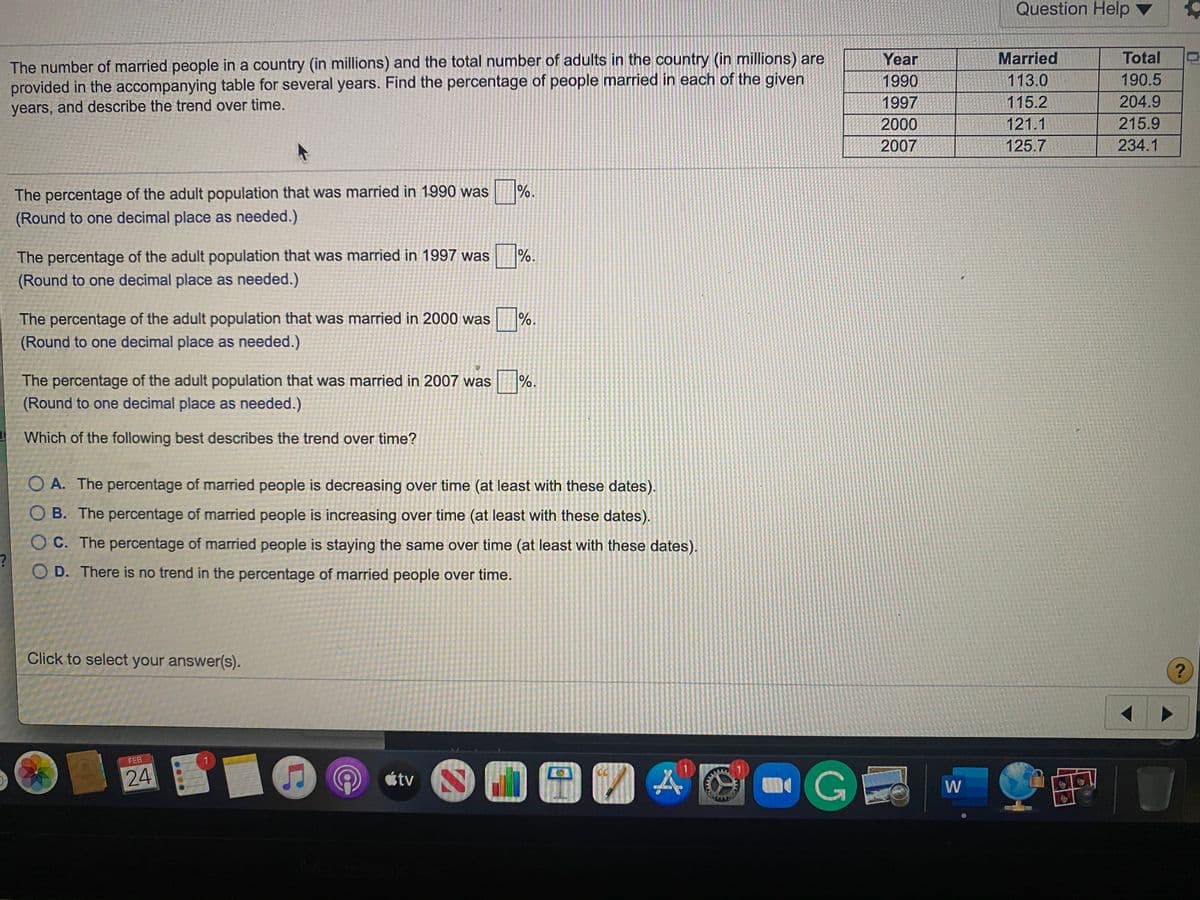The number of married people in a country (in millions) and the total number of adults in the country (in millions) are provided in the accompanying table for several years. Find the percentage of people married in each of the given years, and describe the trend over time. Year Married Total 1990 113.0 190.5 1997 115.2 204.9 2000 121.1 215.9 2007 125.7 234.1 The percentage of the adult population that was married in 1990 was %. (Round to one decimal place as needed.) The percentage of the adult population that was married in 1997 was (Round to one decimal place as needed.) %. The percentage of the adult population that was married in 2000 was %. (Round to one decimal place as needed.) The percentage of the adult population that was married in 2007 was %. (Round to one decimal place as needed.) Which of the following best describes the trend over time? O A. The percentage of married people is decreasing over time (at least with these dates). O B. The percentage of married people is increasing over time (at least with these dates). OC. The percentage of married people is staying the same over time (at least with these dates). O D. There is no trend in the percentage of married people over time.
The number of married people in a country (in millions) and the total number of adults in the country (in millions) are provided in the accompanying table for several years. Find the percentage of people married in each of the given years, and describe the trend over time. Year Married Total 1990 113.0 190.5 1997 115.2 204.9 2000 121.1 215.9 2007 125.7 234.1 The percentage of the adult population that was married in 1990 was %. (Round to one decimal place as needed.) The percentage of the adult population that was married in 1997 was (Round to one decimal place as needed.) %. The percentage of the adult population that was married in 2000 was %. (Round to one decimal place as needed.) The percentage of the adult population that was married in 2007 was %. (Round to one decimal place as needed.) Which of the following best describes the trend over time? O A. The percentage of married people is decreasing over time (at least with these dates). O B. The percentage of married people is increasing over time (at least with these dates). OC. The percentage of married people is staying the same over time (at least with these dates). O D. There is no trend in the percentage of married people over time.
Linear Algebra: A Modern Introduction
4th Edition
ISBN:9781285463247
Author:David Poole
Publisher:David Poole
Chapter4: Eigenvalues And Eigenvectors
Section4.6: Applications And The Perron-frobenius Theorem
Problem 22EQ
Related questions
Question

Transcribed Image Text:Question Help
The number of married people in a country (in millions) and the total number of adults in the country (in millions) are
provided in the accompanying table for several years. Find the percentage of people married in each of the given
years, and describe the trend over time.
Year
Married
Total
1990
113.0
190.5
1997
115.2
204.9
2000
121.1
215.9
2007
125.7
234.1
%.
The percentage of the adult population that was married in 1990 was
(Round to one decimal place as needed.)
%.
The percentage of the adult population that was married in 1997 was
(Round to one decimal place as needed.)
The percentage of the adult population that was married in 2000 was
(Round to one decimal place as needed.)
%.
The percentage of the adult population that was married in 2007 was
%.
(Round to one decimal place as needed.)
Which of the following best describes the trend over time?
O A. The percentage of married people is decreasing over time (at least with these dates).
O B. The percentage of married people is increasing over time (at least with these dates).
O C. The percentage of married people is staying the same over time (at least with these dates).
O D. There is no trend in the percentage of married people over time.
Click to select your answer(s).
FEB
24
G
étv
W
Expert Solution
This question has been solved!
Explore an expertly crafted, step-by-step solution for a thorough understanding of key concepts.
This is a popular solution!
Trending now
This is a popular solution!
Step by step
Solved in 5 steps

Knowledge Booster
Learn more about
Need a deep-dive on the concept behind this application? Look no further. Learn more about this topic, statistics and related others by exploring similar questions and additional content below.Recommended textbooks for you

Linear Algebra: A Modern Introduction
Algebra
ISBN:
9781285463247
Author:
David Poole
Publisher:
Cengage Learning

Glencoe Algebra 1, Student Edition, 9780079039897…
Algebra
ISBN:
9780079039897
Author:
Carter
Publisher:
McGraw Hill


Linear Algebra: A Modern Introduction
Algebra
ISBN:
9781285463247
Author:
David Poole
Publisher:
Cengage Learning

Glencoe Algebra 1, Student Edition, 9780079039897…
Algebra
ISBN:
9780079039897
Author:
Carter
Publisher:
McGraw Hill


Holt Mcdougal Larson Pre-algebra: Student Edition…
Algebra
ISBN:
9780547587776
Author:
HOLT MCDOUGAL
Publisher:
HOLT MCDOUGAL

Big Ideas Math A Bridge To Success Algebra 1: Stu…
Algebra
ISBN:
9781680331141
Author:
HOUGHTON MIFFLIN HARCOURT
Publisher:
Houghton Mifflin Harcourt